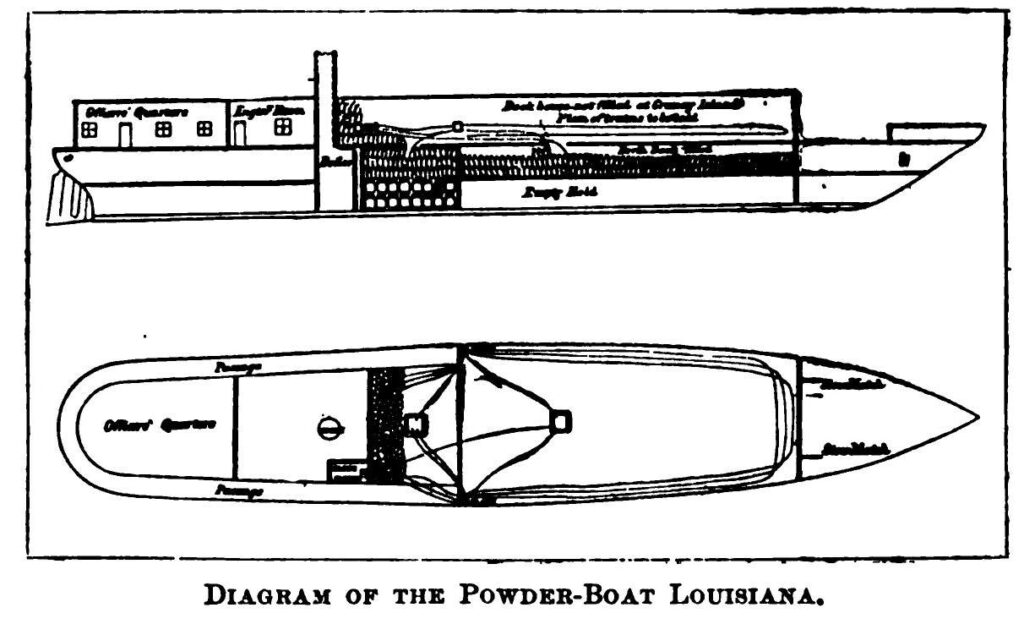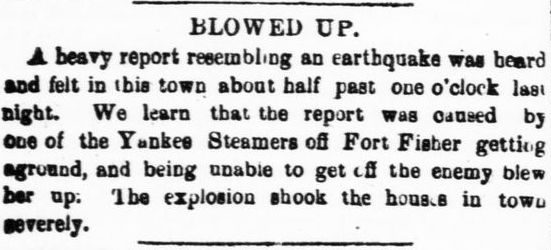The Situation
By the autumn of 1864, an estimated half of the Army of Northern Virginia’s supplies were coming through Wilmington. General Robert E. Lee felt that without Wilmington, he would not be able to defend Richmond. He considered the defense of Wilmington to be critical to the survival of his army.
The war planners in Washington, D. C. were also aware of Wilmington’s contribution to the Confederate war effort. With General Grant bogged down in the trenches around Petersburg, it seemed that the war would continue indefinitely. It was time for the Union to take bolder steps to end the war. That meant closing the port of Wilmington.
The key to Wilmington was Fort Fisher. The fort rested on the tip of Confederate Point (Federal Point before the war) about twenty miles south of Wilmington. Fort Fisher, begun shortly after the war, continued to expand as the war progressed. By the end of 1864, the structure’s sea face extended a mile and mounted twenty-two large-caliber guns. The land approach to the fort was protected by twenty-five guns spread across a set of works 1,800 feet long. The location and armament of Fort Fisher made it a formidable target for a seaborne assault.
The Powder Ship
In September 1864 the War Department in Washington began planning an assault on Fort Fisher. Rear Admiral David Porter was placed in command of the naval forces. The War Department suggested Major General Quincy Gillmore for command of the army contingent of the expedition. General Grant preferred Major General Godfrey Weitzel. Before the two could agree on who would command the land forces, General Benjamin “Beast” Butler used his political connections to be put in command.
Butler came up with a novel idea for subduing Fort Fisher with minimum loss to his soldiers. The Beast read a newspaper story about an ammunition dump exploding on the Thames River in England. The effects of the explosion were devastating. Why couldn’t the Union navy pack a ship full of gunpowder and explode it next to Fort Fisher? The resulting explosion would level the walls of the fort and stun the garrison. An amphibious assault would be a walk in the park after the powder ship had wrecked the Confederate works.
Butler, considered an idiot by most of the other Union military commanders, got a lukewarm reception to his plan. But the Beast insisted. Finally, he received unenthusiastic approval for his scheme. Admiral Porter thought it was worth a try and donated the Louisiana, a worn-out coastal ship, to Butler’s project.

The assault on Fort Fisher was scheduled for early December, but bad weather and a lack of coordination between the army and navy caused the attack to be delayed several times. The navy finally arrived off Fort Fisher on the 23rd of December. Butler’s infantry was delayed and would not arrive until the next evening. Porter decided not to wait and sent the Louisiana toward Confederate Point that night.
The Louisiana was loaded with 185 tons of black powder. Engineers had installed a trigger mechanism that would set off the entire cargo of powder at one time. The warship Wilderness towed the powder boat toward the beach. The crew aboard the Louisiana dropped anchor about 300 yards offshore, set the firing mechanism, and then lit a fire on the aft of the ship to ensure that the powder ignited. The crew scurried onto the Wilderness, which immediately turned and sped out to sea.
When the Louisiana finally went up, a column of fire shot high into the air. Four explosions followed. Then there was nothing but silent darkness. The Rebel sentinels at Fort Fisher barely noticed the explosion, thinking one of the federal blockaders had had an accident. The captain of the Wilderness remarked, “There goes a fizzle.”

John Bellamy, a resident of Wilmington, described the blast: “[T]he people of Wilmington thought it was the most severe earthquake they had ever experienced! It shook the windows in the houses and the crockery from the shelves of the dining rooms, but it had no effect whatever on the stability and strength of the Fort….”
The Aftermath
The powder ship had no effect on Fort Fisher. The Federal fleet pounded the fort for the next two days. Butler landed part of his infantry force on Christmas Day, but quickly decided to withdraw. The Union fleet returned to Virginia.
Beast Butler was relieved of command for failing to capture Fort Fisher.
The Union Navy returned to Wilmington three weeks later and captured the Confederate stronghold.
Barrett, John G. The Civil War in North Carolina. Chapel Hill: UNC Press, 1963. 261-267.
Bellamy, John D. Memoirs of an Octogenarian. 35. Available at ECU Digital Collections: Memoirs of an octogenarian – ECU Digital Collections
Butler, Benjamin F. Butler’s Book. Available on archive.org: Butler’s book : autobiography and personal reminiscences of Major-General Benj. F. Butler : a review of his legal, political, and military career : Butler, Benjamin F. (Benjamin Franklin), 1818-1893 : Free Download, Borrow, and Streaming : Internet Archive
Carroll, Christopher Steven (2020) “The Failed Powder Boat Explosion During the First Attack on Fort Fisher in December 1864.,” Bound Away: The Liberty Journal of History: Vol. 3 : Iss. 2 , Article 7.
Available at: https://digitalcommons.liberty.edu/ljh/vol3/iss2/7
Copyright © 2021 – 2025 by Kirk Ward. All rights reserved.